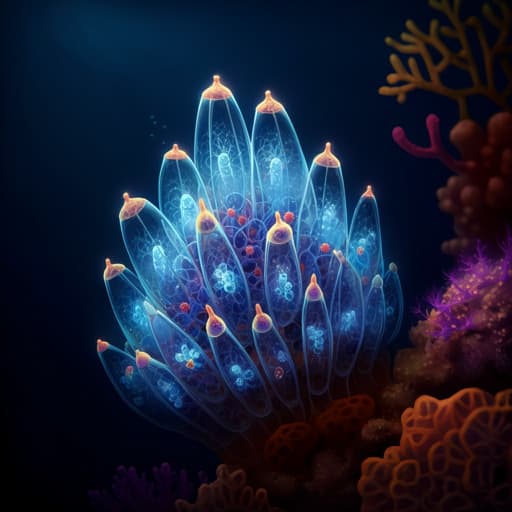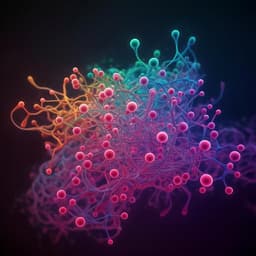
Biology
An AOA-Dominant Microbiome in a Novel Deep-Sea Glass Sponge Species from the South China Sea: Symbiotic Diversity, Adaptation, and Network Interactions
M. Maldonado, L. Pita, et al.
This groundbreaking study reveals a new deep-sea glass sponge species, *Bathydorus* sp. SQW35, from the South China Sea, showcasing its unique AOA-dominant microbiome. Researchers extracted fourteen microbial metagenome-assembled genomes, including a newly identified *Nitrososphaerota* species, and propose a new conceptual framework involving phages that may play a role in sponge holobiont dynamics. This research was conducted by Manuel Maldonado, Lucia Pita, Rodrigo Costa, Laura Steindler, Zhao-Ming Gao, and Yong Wang.
~3 min • Beginner • English
Introduction
Marine sponges (Porifera) are widespread from shallow to deep seas and host dense, diverse prokaryotic communities that can comprise up to 35% of sponge biomass. These sponge–microbe consortia (holobionts) play key ecological roles including nutrient cycling. While shallow-water sponge microbiomes are well-studied, deep-sea sponge microbiomes remain comparatively underexplored despite evidence of unique diversity and prominent archaeal components. Prior research has shown deep-sea sponge symbionts mediate carbon, nitrogen, and sulfur conversions, sometimes with archaeal 16S rRNA gene abundances much higher than in shallow sponges. Viruses are abundant in marine systems and likely influence sponge holobionts due to sponge filtration lifestyles, but deep-sea sponge-associated viromes are poorly characterized. This study aims to characterize the microbiome of a novel deep-sea glass sponge (Bathydorus sp. SQW35) from the South China Sea using genome-resolved metagenomics, to identify dominant symbionts and their metabolic potentials, examine possible symbiotic adaptations (e.g., genome reduction, ELPs), and assess phage diversity and host defense systems (CRISPR-Cas) to propose an interaction framework for the holobiont.
Literature Review
Previous studies have identified extensive microbial diversity in sponges, with up to 63 prokaryotic phyla reported. Deep-sea sponges have key ecological functions and exhibit unique microbiomes, often with prominent archaea. For example, deep-sea glass sponges (e.g., Lophophysema eversa) harbor AOA, NOB, and SOB that together perform carbon, nitrogen, and sulfur cycles; other work highlighted small genomes and low GC content among major deep-sea sponge symbionts, suggesting adaptation to deep-sea conditions. Large-scale analyses revealed distinct deep-sea sponge grounds with unique microbiomes and environmental drivers. Virome studies in sponges (mostly shallow or reef-associated) showed diverse phage communities and suggested tripartite interactions (animal–phage–bacterium). Yet, deep-sea sponge viromes and symbiont phage–host dynamics remain largely unknown. The Cenarchaeum clade within Nitrososphaerota (Thaumarchaeota sensu lato) has been repeatedly identified as sponge-specific AOA lineages. Bdellovibrionota predators have rarely been reported from sponges (notably in Cymbastela concentrica), and their potential symbiotic adaptation in deep-sea sponges has not been clarified.
Methodology
- Sample collection: A single sponge specimen (SQW35) was collected at 18°41′N, 113°22′E from 983 m depth in the South China Sea during R/V Tansuoyihao TS-7 (April 2018) using the manned submersible Deep-Sea Warrior. The specimen was rinsed with 0.22-µm filtered seawater, subsampled (two inner-body technical replicates, ~0.5 cm^3 each: SQW35-1 and SQW35-2), and stored at −80°C.
- DNA extraction: Tissue pieces were incubated in extraction buffer and processed with the PowerSoil DNA Isolation Kit. DNA was quantified with Qubit and stored at −80°C.
- Metagenome sequencing: 100 ng DNA per replicate was sheared (~350 bp), libraries prepared with TruSeq Nano DNA LT, and sequenced on Illumina HiSeq2500 (2×150 bp). Reads were quality-filtered (fastp), deduplicated (FastUniq), and rRNA miTags extracted (rRNA_HMM) for community profiling via QIIME1 (UCLUST at 97% OTU threshold) using SILVA 138; chloroplast, mitochondria, eukaryotic, and unassigned false positives were removed.
- Assembly and binning: Clean reads from each replicate were assembled with SPAdes (metagenome mode) and MEGAHIT. Four assemblies (two methods × two replicates) were binned with MetaWRAP, yielding 38 MAGs; dereplication with dRep produced 14 high-quality MAGs (completeness >50%, contamination <10% by CheckM). Taxonomy and RED were assigned with GTDB-Tk.
- Relative abundance: EukRep identified eukaryotic contigs (>1 kb), reads mapping to these were removed (Bowtie2). Remaining reads were mapped to MAGs to estimate relative abundance using CoverM.
- Global distribution: The 16S rRNA V4 region from dominant MAGs was queried by BLASTN (e ≤ 1e−5) against the Sponge Microbiome Project (SMP) and Deep-sea SMP (D-SMP); hits >96% identity were used to calculate relative abundances in respective datasets.
- Genome annotation: ORFs were predicted with Prodigal. Functional annotation used KofamScan (KEGG), PfamScan (PFAM) for eukaryotic-like protein domains (ELPs), COG database for transposases (BLASTP), and CRISPRminer2 (CRISPRCasFinder, CRT, PILER-CR) for CRISPR-Cas. ANI (pyANI) and AAI (CompareM) were computed versus references.
- Phylogeny: Sponge coxI was annotated with Prokka; 16S rRNA genes from MAGs were predicted (RNA_HMM). Sequences were BLASTed to identify relatives, aligned with MAFFT, trimmed with trimAl, and ML trees inferred with IQ-TREE (TIM2+F+I+G4 for genes; LG+F+R7 for concatenated proteins), 1,000 bootstrap replicates.
- Phage identification: Contigs >5 kb were analyzed with DeepVirFinder, VIBRANT, VirFinder, VirSorter, and VirSorter2; viral quality and contamination assessed with CheckV. Taxonomy was inferred with vConTACT2 gene-sharing networks against RefSeq. Viral abundance was estimated by mapping reads to viral contigs (BWA-MEM).
- Morphology/taxonomy: Sponge gross morphology documented; coxI-based phylogeny used to place the sponge within Hexactinellida and to assess relatedness to Bathydorus species.
Key Findings
- New sponge species: The specimen is a thick-walled tubular glass sponge with a trumpet-shaped osculum, pale beige color, and protruding prostalia. coxI (1,575 bp) phylogeny places it within genus Bathydorus, closely related to B. laniger and B. spinosus with 94.83% and 93.27% identity, exceeding genus-level thresholds; designated Bathydorus sp. SQW35.
- Community composition: 16S miTags showed highly consistent replicates dominated by Nitrososphaerota (AOA; 81.81 ± 2.09%), with bacterial symbionts mainly Gammaproteobacteria (SOB; 10.60 ± 0.85%), Nitrospirota (0.85 ± 0.11%), Planctomycetota, and Bacteroidota.
- Genome recovery: 14 MAGs (completeness 56.15–99.03%, contamination 0–4.69%) across Nitrososphaerota (B01–B05), SAR324 (B06), Pseudomonadota (B07, B13, B14), Nitrospirota (B08), Bacteroidota (B09), Patescibacteria (B10), and Bdellovibrionota (B11, B12). RED values indicate 13 likely novel species; five MAGs at novel genera (RED 0.71–0.89) and three at novel families (RED 0.64–0.69).
- Dominant symbiont: AOA MAG B01 recruited 70.31 ± 1.15% of prokaryotic metagenome reads, vastly dominating the consortium. SOB MAG B14 was second (2.83 ± 0.40%); NOB B08 present at lower abundance. Bdellovibrionota MAGs B11 and B12 mapped 0.29 ± 0.29% and 0.07 ± 0.07% reads and were not detected in 16S miTags.
- AOA lineage: B01 clusters with the sponge-specific Cenarchaeum clade; ANI to Cenarchaeum-related references 68.96–69.97% and RED 0.87 indicates a new genus. SMP query: 100% identity to amplicons from three Dactylocalycidae glass sponges with relative abundances 23.25%, 8.78%, 8.60%. D-SMP query: >99% identity with symbionts in multiple deep-sea glass sponges; low relative abundances likely underestimate due to bacterial primers. Distribution patterns designate B01 as a specialist symbiont.
- Bdellovibrionota symbionts: B11 and B12 fall within Bdello-group2 (classic predators). They have smaller genomes and lower GC content than free-living relatives, lack chemotaxis, flagellum, and type IV pili genes, but retain several penicillin-binding protein genes (PBP1A, PBP1B, PBP2, PBP3, PBP4) while lacking PBP1C, suggesting retained predatory potential with symbiotic adaptation and genomic reduction.
- Metabolic potential:
• Carbon fixation: AOA (Nitrosopumilaceae) possess 3HP/4HB cycle genes (K18594, K18593). NOB B08 encodes near-complete rTCA cycle (e.g., K01647, K01676, K00240). SOB MAGs (Gammaproteobacteria) encode >90% of CBB cycle including RuBisCO (K01602, K01601).
• Nitrogen cycling: amoABC (K10944–K10946) present only in AOA (B01, B04, B05), indicating AOAs perform ammonia oxidation. NOB B08 has nitrate/nitrite transporter (K02575), urea uptake (urtABCDE: K11959–K11963), and urease (ureABC: K01428–K01430), indicating urea utilization; lacks nitrite oxidoreductase genes in assembled MAG.
• Sulfur metabolism: SOB B13/B14 encode adenylyl-sulfate reductase (K00394/K00395) and sulfate adenylyltransferase (K00958); B14 has soxAXYZ (K17222, K17223, K17226, K17227) for thiosulfate oxidation. Taurine utilization present (tauAC K15551/K15552; taurine-pyruvate aminotransferase K03851; sulfoacetaldehyde acetyltransferase K03852), enabling conversion to sulfite for SOX-driven oxidation.
- Eukaryotic-like proteins (ELPs): Ank domains present in five of nine bacterial MAGs (incl. SOB B14, NOB B08); Bdellovibrionota B11 has the most Anks (n=12). TPR domains are widespread across MAGs (except B10). AOA B01 encodes the highest number of NHL domains; NOB B08 also enriched in NHL.
- CRISPR-Cas: Nearly all MAGs encode Cas proteins; CRISPR arrays detected in B01, B08, B09, B11, B13, B14. Spacer counts: AOA B01 (85), SOB B14 (81), Bdellovibrionota B11 (51), indicating robust antiviral defense among dominant symbionts.
- Phage diversity: 125 and 148 viral contigs (>5 kb) predicted in SQW35-1 and SQW35-2, respectively; after redundancy removal, 232 unique viral sequences identified. The most abundant phage contig accounted for 1.48% and 2.19% of reads in the two replicates. Many phage proteins are of unknown function; viral taxa largely unassigned.
Discussion
This genome-resolved study of a new deep-sea glass sponge (Bathydorus sp. SQW35) reveals an archaeal AOA-dominated microbiome, a feature consistent with deep-sea sponge ecosystems where ammonia oxidation and chemolithoautotrophy are central to holobiont metabolism. The dominant AOA B01, likely representing a new genus within the sponge-specific Cenarchaeum clade, suggests strong specialization and potential reliance of the host on archaeal nitrification and autotrophic carbon fixation via the 3HP/4HB cycle. Complementary autotrophic pathways (rTCA in NOB and CBB in SOB) indicate functional redundancy and metabolic versatility for CO2 fixation within the holobiont, supporting host nutrition in oligotrophic deep-sea environments. The identification of two Bdellovibrionota lineages with reduced genomes, lower GC content, loss of motility, and retained peptidoglycan-targeting PBPs implies a symbiotic, potentially predatory lifestyle adapted to the sponge environment, possibly influencing bacterial population dynamics. The widespread ELPs (Ank, TPR, NHL) across symbionts suggest diverse strategies to interface with sponge host processes and avoid phagocytosis. High prevalence of CRISPR-Cas systems, especially in dominant taxa (AOA B01 and SOB B14), together with a rich, largely unclassified phage community, supports a dynamic phage–host arms race shaping community structure and stability. Overall, the findings address the central hypothesis that deep-sea sponge holobionts harbor specialized, metabolically integrated symbionts with adaptations to host association and viral pressures, forming a network that recycles nitrogen and sulfur wastes, fixes carbon, and maintains holobiont homeostasis.
Conclusion
The study describes a novel deep-sea glass sponge, Bathydorus sp. SQW35, with a microbiome dominated by a previously undescribed AOA lineage (B01) likely representing a new genus within the Cenarchaeum clade. Fourteen MAGs spanning seven phyla were recovered, with most representing novel taxa. Bdellovibrionota predators (B11, B12) exhibit genomic signatures of symbiotic adaptation (reduction, low GC, loss of motility), suggesting predatory roles within the holobiont. Multiple autotrophic carbon fixation pathways (AOA 3HP/4HB, NOB rTCA, SOB CBB) and key nitrogen and sulfur transformations underscore a metabolically integrated consortium. Proliferation of CRISPR-Cas systems and a diverse, largely unassigned phage community indicate strong viral pressures and defense responses, likely regulating symbiont populations. This work advances understanding of deep-sea sponge symbioses, evolutionary adaptations, and phage involvement in holobiont networks. Future research should target cultivation/functional validation of dominant symbionts, phage–host linkage resolution, in situ activity measurements (e.g., metatranscriptomics, stable isotope probing), and broader sampling across individuals and environments to assess generality.
Limitations
- Single sponge individual analyzed; lack of biological replicates limits generalizability.
- No paired ambient seawater or sediment controls; uncertain which microbes and phages are intrinsic to the sponge versus transient from the environment.
- Some MAGs are incomplete; absence of certain pathway genes (e.g., nitrite oxidoreductase in B08) may reflect assembly gaps.
- Phage taxonomy largely unresolved; functional roles inferred indirectly from CRISPR and abundance data without experimental validation.
Related Publications
Explore these studies to deepen your understanding of the subject.







